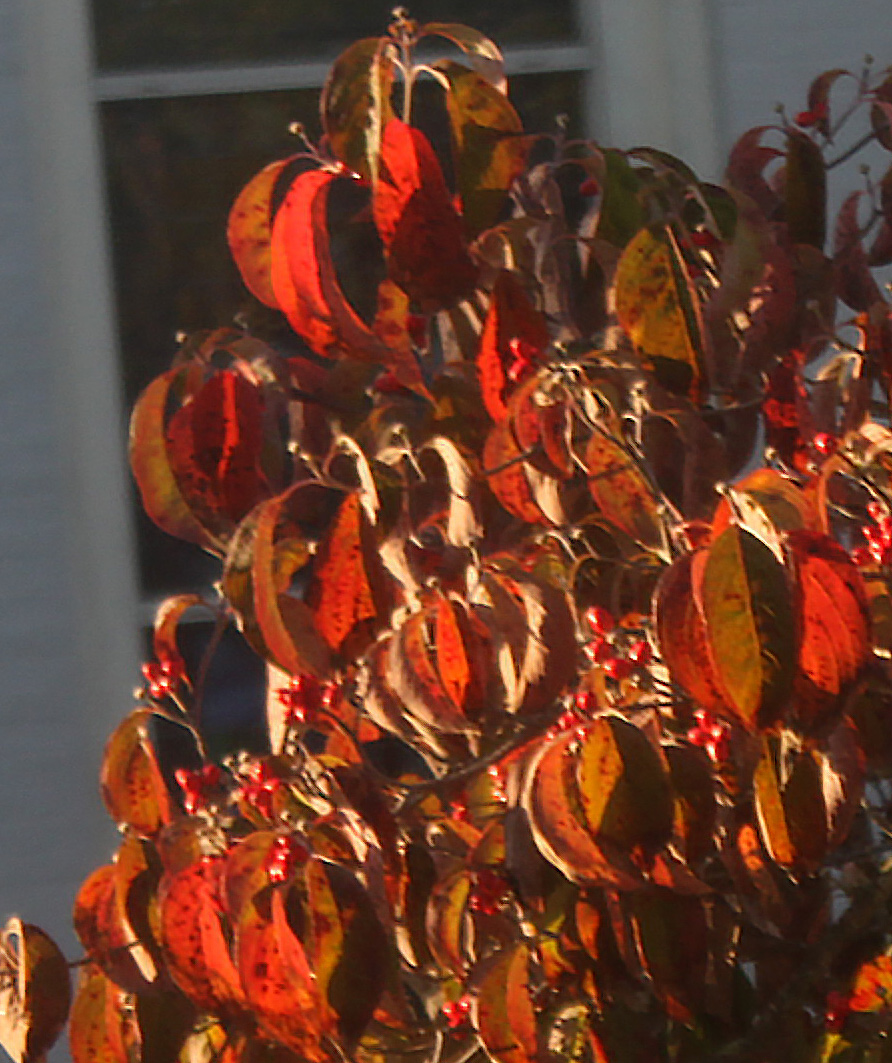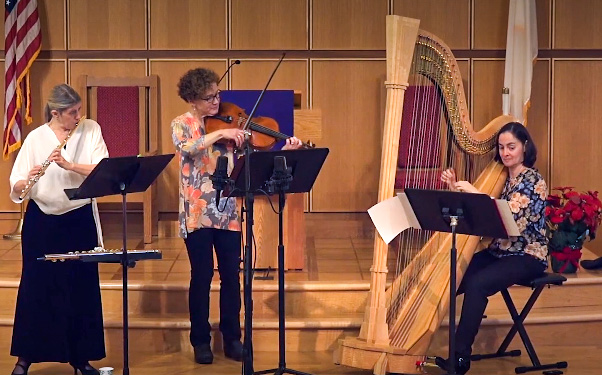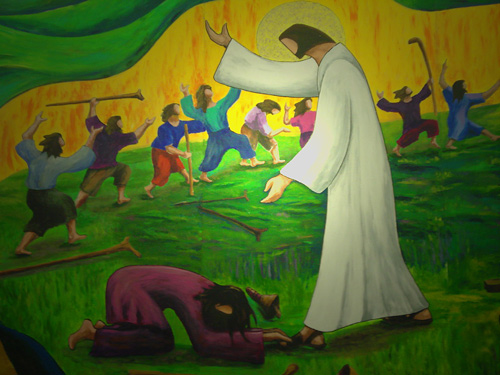
"Jesus Heals the Ten Lepers" (17th century, unknown)
The lectionary readings are here or individually:
First Reading – 2 Kings 5:1-3, 7-15c
Psalm – Psalm 111
Epistle – 2 Timothy 2:8-15
Gospel – Luke 17:11-19
Today’s readings remind us of the wholeness we experience when we allow God to heal and forgive In 2 Kings, Naaman’s healing leads him to acknowledge the one true God. Paul reflects on the centrality of Jesus Christ, who is himself the good news, bringing salvation. In today’s gospel, 10 lepers receive healing; one healed leper receives salvation.
Sometimes in the faith journey we feel like failures. We want to give up. We have done our part to share the Good News, nothing we do seems to bring people in, and still others even question our motives for what we are doing (think Elisha and Naaman). However, when we are faithful to God, we will see God’s faithfulness in us. Sometimes we are like the lone Samaritan who recognizes what God has done. Sometimes we are like Naaman, pulling and fighting all the way. And sometimes we are like Jesus, wondering what happened to all the others, but knowing that one is enough. The seeds are planted. Live in faithfulness, and you will experience God’s faithfulness in you.
The healing in today’s gospel occurs “on the way.” This sounds a contemporary note. As Jane Redmont writes in Generous Lives: "Commuting time seems to have become the privileged place of prayer in North America."
Modern commuters have made the same discovery as first-century lepers. Simply because we’re on our way to something else does not mean that Jesus can’t intersect us. We meet Jesus on the L.A. freeway, the Washington D.C. Metro and the barbed wire along the Rio Grande.
We meet God in the spaces between certainties. As one retreat director said, "95% of your life may be just fine, and you don’t mind revealing it to anyone. It’s the other 5% we’re concerned with." In the shadowy, unstable, insecure areas, we need healing. There we are most likely to feel the touch of Jesus’ hand.
And how do we respond? As usual, the answer comes in story form. Just as the despised Samaritan would show Jews how to be good neighbors (Luke 10:30-37), so a "foreigner" demonstrates how to receive a gift. Healing is offered to all 10 lepers, just as rain and sunshine fall on all people. But the ability to recognize the blessing and express gratitude for it seems to be more unique. "You sanctify whatever you are grateful for," writes Anthony DeMello.
The disease part of the Old Testament readings and Gospel has been reinterpreted Indeed, in modern translations, the word “leprosy is” not used, but is represented by the term “scaly infection”. This condition is actually several, referring not only to skin disease, but also to fungal infestations of fabric and of walls. Such skin conditions may represent psoriasis, mycotic infections, eczema, or pityriasis rosea. All were tied to the ritual impurity codes of the Hebrew Scriptures. In the Gospel reading today, Jesus encounters ten lepers, and their condition may be more connected to the ancient understanding of tzaraath than to our modern understanding of leprosy. It is interesting that the “leper” (a Samaritan) who returns thanks exhibits a double problem of ritual purity – his skin and his race.
II. Summary
First Reading – 2 Kings 5:1-3, 7-15c
Kings Naaman was army commander of a tribe that was a rival of Israel. Israel has been raided by a Syrian army and now the story turns to a captive – a young girl who now is in service to the General Naaman. It is at her suggestion that this prominent man go to Israel for healing and Israel’s prophet Elisha. Naaman has leprosy or something similar.
Naaman finds the prophet and hears his prescription. The King of Israel sees a trip that will strip him of his kingship, and Naaman bristles at the lack of hospitality he receives at the prophet’s home, and is even more insulted at the prophet’s suggestion that he bathe in the Jordan. Naaman feels humiliated. He had hoped for a word of power, but got a call to obedience that required him to wade into the grimy Jordan River.
Naaman’s submission brings him into new life, both physical and spiritual. He becomes a visual testimony, both to wayward Israel and to the Gentile nations, that only submission and an attitude of trust can lead to wholeness and righteousness (a right relationship with God.)
Most of the prophetic passages in the Hebrew Scriptures are for the Hebrew listeners of Israel and Judah—and when the focus is outside of their people, it is usually contained in the passages of judgment. However, this time, the focus is not judgment, but healing for the commander of the occupying army. This passage may allude to the coming exile, and proclaims faith in God and hope for all, even hope for converting the oppressors.
God is the cause of Naaman’s success (because by him God had granted the victory to Aram) and it is God who will effect the healing through the prophet. The agent, a young girl, shows the power of this God who uses such a lowly person. When Naaman is healed his skin is described as that of a young man. Thus are contrasted the agent and the recipient, both displaying the power of the God of Israel, and Aram!
Psalm – Psalm 111
Psalm 111 is a psalm of praise, celebrating God’s presence in the history of God’s covenant relationship with Israel. It is a short acrostic with each half line beginning with a letter of the Hebrew alphabet. The psalmist recites a brief history of God’s actions as clues to God’s character. This psalm sings of God’s faithfulness to the people through the mighty acts of God. The psalmist gives thanks to God for all that God has done, and reminds the listeners of God’s love, faithfulness and redemption.
Here, as in the first reading, God acts amongst all the peoples – “great are the deeds of YHWH, discovered by all who desire them.” The exact deeds are not recounted but are present for all to see. The citing of wisdom (the fear of the Lord) is a nod to the common knowledge that is given to all the nations.
Epistle- 2 Timothy 2:8-15
Timothy held an office that would evolve into that of a bishop. Paul, senior apostle now in prison, loved his young friend of long standing and one-time missionary companion. Today’s passage is part of Paul’s encouragement to Timothy. It’s not a structured theological treatise, but more a collection of pithy sayings designed to bolster Timothy. Note that Paul is not too modest to cite his own experiences if that’s what the disciple needs to know. By way of encouraging Timothy, Paul quotes an early Christian hymn.
Today’s reading consists of an eloquent last testament of Paul (vv. 8-10) and a quotation from a baptismal hymn (vv. 11-13), sandwiched between some proverb-like sayings (vv. 3-7) and advice on dealing with heretics (vv. 14-15). The sayings use favorite metaphors of Paul’s to urge single-minded commitment, self-discipline and labor for reward.
In the initial verses of this reading, the author reminds Timothy of the central focus of the Gospel namely “Jesus Christ, raised from the dead, a descendant of David”. Here the continuity of Christian teaching and the Hebrew Scriptures is underscored once again. The next verse in which “Paul” talks about his condition of imprisonment (chained) uses the image to talk about the unfettered nature of the Gospel.
2 Timothy 2:8-15 reminds the reader to endure in faith, that Christ endures with us. The poem in vs. 11-13 remind us that Christ is with us in life and death and endures with us. It explores a series of contrasts (dying with him, living with him, persevering/reigning vs. denial, unfaithful vs. faithful).
The hymn recalls the reality of baptism, perhaps in answer to persecution and the temptation to deny Christ. Even then the lord is faithful. The warning only is for when we deny him, but even when we fail, and our faith falters, Christ’s faithfulness endures forever. The writer gives a warning about “wrangling over words” (vs. 14) because often arguing over words fails to produce agreement or anything good. Rather than arguing, fighting the fight, going the journey alone—we are reminded that Christ is indeed on the journey with us, has gone before us, and remains faithful even when we fail.
In dealing with his opponents, Timothy is to avoid argumentation, presenting "the word of truth" (v. 15), the gospel, with which he has been entrusted.
The reading from I Timothy grounds Christian hope in the resurrection. Christ’s triumph over death gives us confidence and courage in the face of every threat. In light of the resurrection, the author has hope, despite the constraints of imprisonment. As mysterious as it may be to us, resurrection is an image of hope: God is faithful when we are faithless. God will give us life in the midst of death. In light of the resurrection, we are challenged to go beyond divisiveness, much of which is the result of clinging to words rather than the reality toward which they point.
Gospel – Luke 17:11-19
Jesus continues to make his way to Jerusalem, where death and resurrection await him. He praises the faith of someone not a member of the fold. He is virtually standing in a no-man’s land (through the region between Samaria and Galilee). Jesus adds to the ambiguity by sending those pleading for healing “to the priests”. Are they intended to go to Jerusalem or to another shrine, a Samaritan shrine. Jesus doesn’t elaborate and leaves us in a vague space.
The story of the cleansing of the 10 lepers is found only in Luke. His focus, however, is not in the healing but in the response. While all are healed, and all are told to go show themselves to the priests, only one returns to thank Jesus when he is healed—and he turns out to be a Samaritan. Jesus said “Your faith has made you well.” The others perhaps were just looking to move on with their lives, to get back to normal—but this one knows that his life has been changed forever.
Faith is the distinctive behavior that separates out the Samaritan (and others) and sets them on their way to a new destination. The healing miracle is real for all 10 but is not equivalent to salvation, which requires a change of inner orientation. Jesus, the beneficent healer, gives grace to all and receives thankful homage from the foreigner. The leper’s faith has made him whole and has also saved him.
As this story is juxtaposed with last week’s parable (17:7-10), we learn that Jesus’ disciples are exhorted not to seek thanks but to give it. Jesus is still answering the request of the disciples from last Sunday, “increase our faith”. By focusing on those seen as outside of salvation, Jesus points out God’s mercy and care for all people. The Samaritan’s future and destination is changed and Jesus points out, like those who were in exile in Babylon, that there is a future and life in the place that God has given us.




 Yours are the hands, with which he blesses all the world.
Yours are the hands, with which he blesses all the world.
